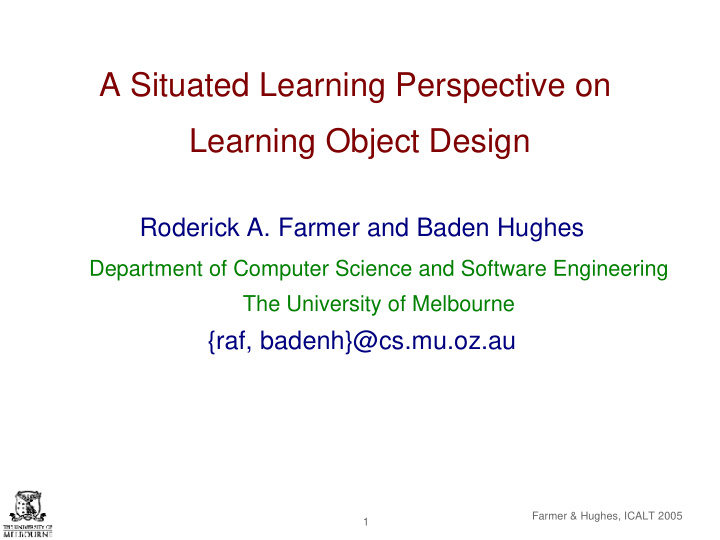



A Situated Learning Perspective on Learning Object Design Roderick A. Farmer and Baden Hughes Department of Computer Science and Software Engineering The University of Melbourne {raf, badenh}@cs.mu.oz.au Farmer & Hughes, ICALT 2005 1
Overview Background and Introduction ● Situated Learning Perspective ● The CASE Framework ● Discussion ● Future Work and Conclusions ● Farmer & Hughes, ICALT 2005 2
Introduction Learning object design inclusive of instructional design and ● learning theories is seen as desirable (Daniel and Mohan, 2004; Nabeth et al 2004) Addressing the socio-technical gap between technical capacity and – social valency (Ackerman, 2000) We argue for a shift towards holistic, socially-informed ● approach to learning object design using situated task analysis (CASE) (Farmer, to appear) – Our motivation is primarily to explore the role of context and ● situatedness in learning object design proposing retention of context in contrast to other work (Parrish, 2004) – Farmer & Hughes, ICALT 2005 3
A Situated Learning Perspective Grounded in social cognition (Brown et al, 1989) and social ● learning theories (Vygotsky, 1986) , learning is viewed as a process or function of an activity located within a community of practice We argue that situated learning applied to learning object ● design is critical as it recognises that motivation, situational awareness, collaboration, conflict and negotiation, context, and learner-centeredness have an impact on learner environments (Farmer, to appear; Brown et al, 1989; Engestr ö m, 1999) CASE framework (Farmer, to appear) allows the capture of social ● and cognitive aspects within a learning paradigm Farmer & Hughes, ICALT 2005 4
The CASE Framework (1) Cognition, Activity, Social Organisation, Environment ● each defining an investigative locus for situated learning – Captures situational factors impacting the learning context ● Factors from each segment can interact summatively ● Interactions cannot be modelled in a purely linear fashion as ● lower level events (eg error handling, information coherence) may impact higher level meta-cognitive functions Farmer & Hughes, ICALT 2005 5
The CASE Framework (2) Descriptive/Qualitative Analytical/Quantitative Environment Conventions Affordances Activity Agency Negotiation Motivation goals difficulty Tools Cognition Situatedness Control complexity collaboration Roles Conflict Work Relationships Practice Culture Social Organisation Artefacts Conditions + -/+ Rate of Change Farmer & Hughes, ICALT 2005
The CASE Framework (3) Cognition consists of 2 primary factors: task complexity and ● difficulty. These impact creation and maintenance of: conscious subject goals – unconscious subject actions (habituated) – Activity captures tool-mediated subject-motivated interaction ● based on Activity Theory Social Organisation emphasises culture, conventions, agency ● Environment is concerned with affordances, artefacts and ● conditions Farmer & Hughes, ICALT 2005
Discussion Integrated instructional design and social theory ● considerations into learning object design through foundations in situated learning in Component-Based Software Development (CBSD), elicitation of the – functional properties of learning objects is a critical requirement A number of implicit assumptions and constraints within the ● CASE framework Formal properties and associated ontologies exist by which to constrain – and describe learning objects CASE is unable to describe sequencing impacts (Robinson, 2001) – Farmer & Hughes, ICALT 2005 8
Future Work and Conclusions Static frameworks are commonly criticised for their failure to ● capture all modes and aspects of interaction The ability of CASE to model individual and collaborative aspects of – cognition, interaction and sociocultural constraints offers new insight into learning object design and evaluation Further research required into evaluating the impact of ● dynamic conditions during collaboration, despite CASE capacity to model spatio-temporal conditions Tying historical context to present and future conditions (Vygotsky, 1986; – Engestr ö m, 1999) Socio-culturally- aware aggregation methods (Nabeth et al, 2004) – Farmer & Hughes, ICALT 2005 9
References Daniel and Mohan, 2004. A model for evaluating learning objects. Proceedings of ICALT 2004 . IEEE ● Computer Society Press. Nabeth et al, 2004. Integrating 'context' in e-learning systems design. Proceedings of ICALT 2004 . IEEE ● Computer Society Press. Ackerman, 2000. The intellectual challenge of CSCW: the gap between social requirements and technical ● feasibility. Human Computer Interaction 15(2-3). Farmer, to appear. Situated task analysis in learner-centred CALL. In P. Zaphiris (ed), User Centred ● Computer Aided Language Learning . Idea Group Publishing. Parrish, 2004. The trouble with learning objects. Educational Technology, Research and Development 51(1). ● Brown et al, 1989. Situated cognition and the culture of learning. Educational Researchers 18 (1). ● Vygotsky, 1986. Thought and language . MIT Press. ● Engestr ö m, 1999. Activity theory and individual and social transformation. In Y. Engestr ö m et al (eds), ● Perspectives on Activity Theory . Cambridge University Press. Leont'ev, 1978. Activity, consciousness and personality . Prentice Hall. ● Robinson, 2001. Task complexity, cognitive resources and second language syllabus design. In P. Robinson ● (ed), Cognition and Second Language Instruction . Cambridge University Press. Farmer & Hughes, ICALT 2005
Recommend
More recommend